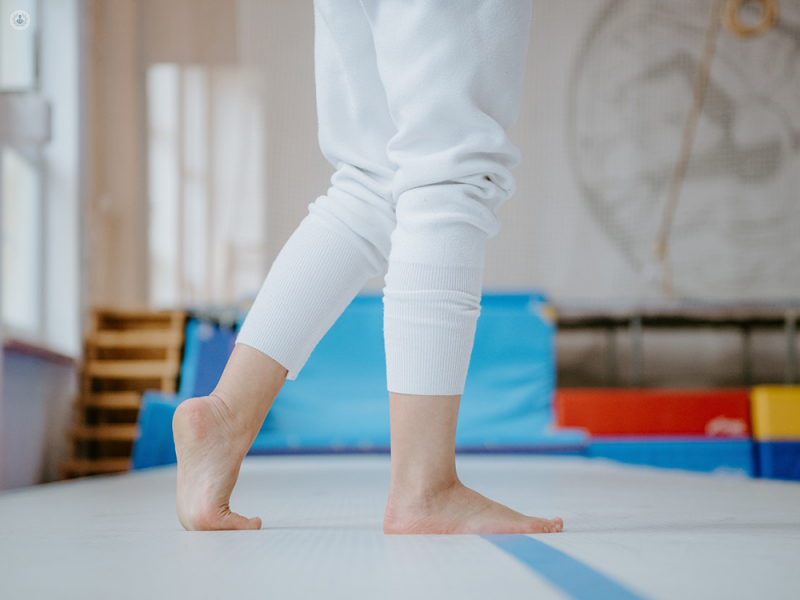Understanding Achilles tendonitis: Causes, diagnosis & treatments
Autore:Achilles tendonitis can affect athletes and sedentary persons alike. The condition, which often results from an overuse injury, causes acute pain and inflammation to the Achilles tendon. Symptoms are usually short-lived, but if they don’t resolve, over time the condition can progress to a degeneration of the tendon and cause further problems.
We spoke to Mr Rohit Madhav, renowned consultant orthopaedic and trauma surgeon, to understand more about Achilles tendonitis, the most common causes, and what treatments are available.

What is Achilles tendonitis?
Achilles tendonitis is a term used to describe an overuse injury leading to inflammation of the Achilles tendon - the largest tendon in the body which connects the calf muscles to the heel bone.
The term Achilles tendonitis encompasses a variety of conditions; however, the use of this terminology varies considerably among specialists. The spectrum of Achilles tendon disorders compromises of:
- Paratenonitis — inflammation of the sheath of the tendon. This is the surrounding tissue that envelopes the tendon.
- Tendinosis — which involves degeneration changes to the quality and architecture of the tendon itself from chronic overuse.
- A combination of both paratenonitis with tendinosis.
Achilles tendonitis can cause pain and inflammation along the back of the lower leg and above and near the heel area.
What causes Achilles tendonitis?
Being the largest tendon in your body, your Achilles tendon is able to endure a great amount of stress while jumping, running, sprinting, dancing, and carrying heavy loads.
That being said, it can be prone to damage particularly from overuse or a direct injury. The main problem normally results from repetitive stress by one or more of the following:
- An abrupt change in intensity and exercise activity e.g. doing too much too soon, speeding up or slowing down suddenly, pivoting, etc.
- Engaging in a familiar activity but changing your environment, the terrain or type of footwear you use.
- Biomechanical and/or muscle imbalances, particularly tightness and joint stiffness.
What are the symptoms of Achilles tendon disorders?
You may notice mild to moderate pain and stiffness around the heel region first thing in the morning or after you have been sedentary for a while. The pain and discomfort will typically increase when you engage in physical activity and after exercising.
Additionally, you may see localised swelling in and around the tendon region, and you may find that the swelling worsens throughout the day.
If you suddenly felt or heard a pop in the back of your calf or heel with an immediate onset of pain and difficulty walking, then there is a very high possibility that you have torn or ruptured your Achilles tendon. This incident requires an urgent assessment by a specialist.
How is Achilles tendonitis diagnosed?
A specialist will first carry out a physical examination of the foot and heel, and may ask to see you walk so they can look for any factors that might have led to the injury.
There is also a range of tests that can be performed, such as X-rays, MRIs and ultrasound scans, which can be used to confirm the diagnosis. From then on, an appropriate treatment programme will be offered.
How is Achilles tendonitis treated?
In most cases, treatment for Achilles tendonitis doesn’t require surgery. A specialist will usually offer an individualised programme of physiotherapy and will suggest the use of special insoles to correct any biomechanical problems.
Physiotherapy might include:
- Concentric or eccentric stretching
- Muscle-strengthening exercises
- Joint mobilisation
- Manual tissue release
- Massaging
- Icing
Other treatment options might include:
- Resting the tendon using a cast or special removable boot
- Ultrasound-guided injections around the tendon using platelet-rich plasma (PRP) or stem cell therapy
- Cortisone injections
- High volume saline injections (HVI)
- Extracorporeal shockwave therapy (ESWT)
What type of surgery is required?
Surgery is required when all other treatments fail to heal the Achilles tendon injury. This usually happens when there are significant signs of degeneration or poor healing potential.
The types of surgery required vary from:
- Gastrocnemius recession - releasing the gastrocnemius muscle and subsequently lengthening the calf muscle to loosen any tightness.
- Paratenon stripping - cleaning the scarred and tightened sheath.
- Tendon debridement and repair - inflamed and damaged tissue is cut away to smoothen the tendon surface and reveal healthy tissue.
Sometimes, the tendon tissue can be very unhealthy or there is extensive damage to it. In this case, a very useful option would be to perform a flexor hallucis longus transfer as an additional procedure.
How long does it take to recover from surgery?
The recovery period varies depending on the degree of the injury and extent of surgery, however, most people respond very well and recover quickly. It is very important to incorporate physiotherapy into the recovery process to optimise healing.
What complications can occur?
The most common complications following any type of Achilles tendon surgery may include stiffness and swelling, however, this normally improves over 9 - 12 months. Rarer complications include infection and nerve injury.
Most patients recover fully without any complications; however, around 15 per cent of patients don't get completely better as sometimes, during the recovery period, the tendon can rupture despite undergoing a specialist rehabilitation programme.
Mr Rohit Madhav is an internationally-trained expert in complex foot and ankle surgery. If you would like to book an appointment with Mr Madhav, don't hesitate to head on over to his Top Doctors profile today.


